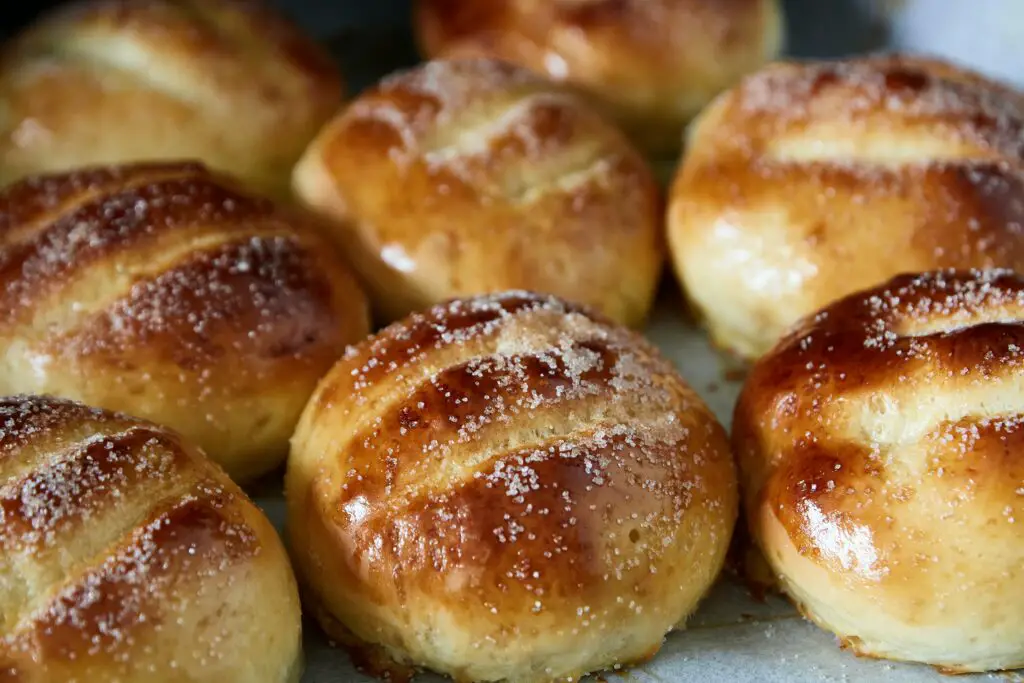Bread is a popular food consumed in every household and undoubtedly, readily available without scarcity. The French bakeries offer varieties of bread made from different types of flour including all-purpose flour, rye flour, wheat flour, corn flour, etc. so, whatever your preference is, there’s likely a bread for you. Let us know more detail about ‘Different Types Of French Bread’.

Different Types Of French Bread
The different types of French bread includes Baguette, Croissant, Brioche, pain de Campagne, Prospera, Boule de pain, Faluche, Pain Couronne, Gibassier, Fouee, Pain Brie, Le Cramique, pain a L’ail, Fougasse, Miche, Viennose, Pain Au Chocolat, etc.
The 5 common types of French bread
There are over 15 types of French bread, made in different shapes and forms, with varying ingredients. Next time you visit a French bakery, check out five of the most common French bread you can look out.
- The Baguette or Le Pain
- Le Croissant
- Brioche
- Pain de Campagne
- Ficelle
The Baguette or Le Pain
As the most popular French bread, the Baguette size sets it apart from others because it is about 1.5 inches high and has a basic length of 2 inches but can extend up to 25 inches (depending on the bakers’ choice). Another characteristic that sets the baguette apart from other French bread is the texture.
The outer part has a deep golden crust with a crunchy and crispy taste and becomes chewy if you leave it for a few days after baking. The baguette is like a national symbol for the French, which is why you can find it in every bakery in France and most bakeries abroad.
Le Croissant
Even if you don’t live in France or haven’t been to Paris, you will still be conversant with the Croissant because it is a popular continental dish mostly consumed with coffee.
The Croissant is a buttery and flaky textured bread with a hard surface that goes through a lot of rolling and folding processes to get the croissant shape, which means crescent in English. Unlike the Baguette, Croissant contains enough butter in all its layers, making it puffy and flaky; however, the golden brown outer layer remains crunchy.
Brioche
Unlike most French bread that sticks to the four-ingredient rule, Brioche plays outside the tradition, featuring high butter and egg content that gives it lightweight and makes it puffy and sweet. Brioche goes well with tea or coffee.
The ordinary brioche has a rectangular shape, but sometimes, bakers get creative forming the dough into a braid, bouquet of muffins, etc.
Pain de Campagne
If you are looking for versatile French sourdough bread that is servable with any meal for lunch or dinner, Pain de Campagne should be your go-to.
This large and round loaf of bread is made from a combination of white and wheat-rye flour, meaning that it is not fluffy or lightweight bread plus the outer part is hard and crusty. Also, the large size makes it a perfect option for serving plenty of people.
Ficelle
The salty taste and spongy inner texture of this French bread make it chewy, while the exterior is crunchy. And because it has almost the same ingredient as a baguette, you can easily substitute it for a baguette on a formal occasion.
Ficelle is a perfect breakfast option but let it sit for a few days after baking before consuming to make it more chewy and enjoyable.
What is the most common French bread?
The baguette is the most common French bread. Most times, when you refer to “French bread” most people think you are referring to a baguette.
Since the 29th century, the baguette has been known as the symbol of the French culture and has a simple recipe despite being versatile, allowing you to create many dishes from it including paninis, french toast, bruschetta, chocolate bread, etc.
What makes French bread different?
Unlike bread from other countries, there is a French law that states that long loaves of bread and boules should contain only four ingredients- flour, salt, yeast, and water.
Also, most French bread has a crusty outer part with soft and light crumbs unlike bread from other regions which have dense crumbs. Furthermore, apart from being narrow and long, French bread is known for its decorative patterns, which will keep your taste buds craving them at first sight.
Conclusion
Because French bread can pass for any meal at different times of the day, choosing one will depend on the meal you are planning. For instance, a baguette can be eaten for breakfast, lunch, dinner, and even dessert, while croissants are mostly enjoyed with coffee for breakfast.
Also, French bread isn’t made to be eaten alone; butter, chocolate dip or spread, honey, cheese, etc., will make the bread tastier and more fun to consume. Finally, don’t get offended if your French bread is placed directly on the bare table because that is how it is served even in most fancy restaurants in France.
FAQ
- Can I bake French bake myself at home?
Yes, you can.
- Can I serve French bread as dessert?
Yes. You can make it into a French bread pudding or get creative with your recipes.
- What are the main ingredients in French bread?
Flour, yeast, salt, sugar, water, and oil (avocado, olive, vegetable, or canola oils, etc.)
- Where does the name Baguette come from?
Baguette in English means a gem with a narrow and rectangular shape. The French bread “Baguette” takes this shape, hence the name.


